The 2013 MacBook Air Review (13-inch)
by Anand Lal Shimpi on June 24, 2013 12:01 AM ESTCPU Performance
To measure CPU performance we begin with a fairly standard measure of system responsiveness: boot time. With the last generation of upgrades to 6Gbps SATA, we saw a good decrease in boot time over the previous generation platforms. The new 13-inch MBA's PCIe SSD takes the crown as it boots ever so slightly quicker than last year's setup. In practice the difference is subtle, but something you can appreciate as the 2013 MBA's IO is just snappier all over.
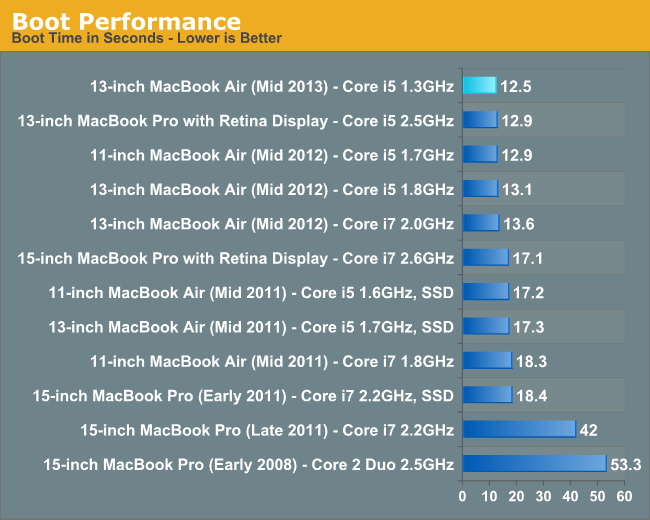
These next two charts look at single and multithreaded floating point performance using Cinebench 11.5. This test also gives us the rare opportunity of comparing to some older Mac Pro hardware as well from 2008 - 2010. Single threaded performance remains extremely important to overall system responsiveness, so it's always good to look at. As we found in our initial look at the new MBA, the 1.3GHz Core i5 CPU ends up performing about the same as last year's 1.8GHz part. I'd like to say it's all because of cooling and turbo boost, but in all likelihood Apple is trading some of Haswell's IPC gains for frequency here - enabling identical performance, at lower clocks thanks to Haswell's more efficient architecture.
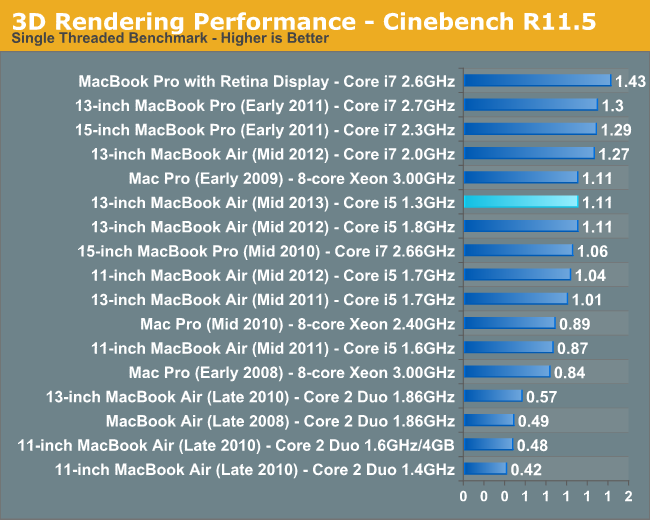
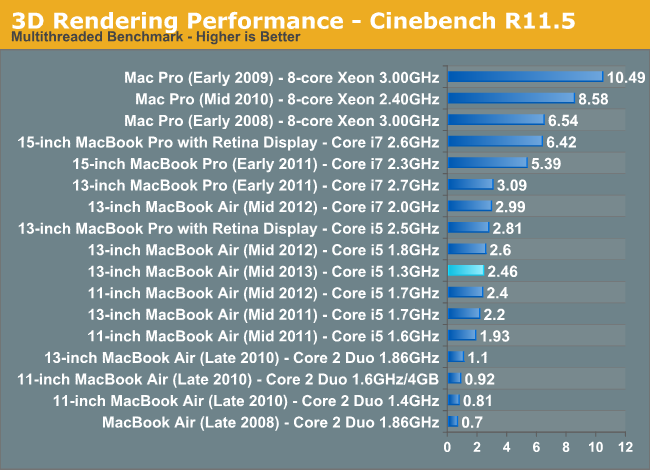
The multithreaded performance story is a bit different. The 1.3GHz i5 regresses in performance by about 5%. Overall performance is still quicker than the 2011 models, as well as the i7 based 11-inch MBA from 2012. Here we're simply seeing the 15W TDP limits come into play. Sharing both PCH and dual-core CPU power in a lower thermal footprint than last year's CPU alone is responsible for what we see above.
Video transcoding is really best suited for the higher end machines, but that doesn't change the fact that it's done on MacBook Airs as well. We'll start by looking at performance under iMovie. Here we're importing 1080p video from a Nikon D7000 and optimizing it during import.
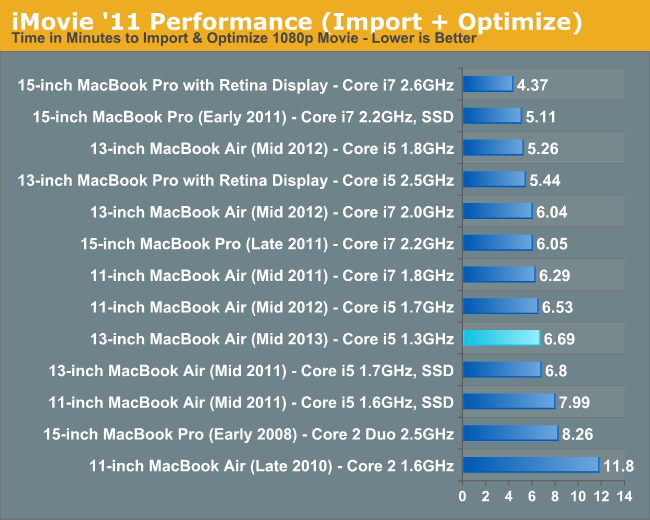
The 13-inch 1.3GHz Core i5 configuration performs similarly to last year's 11-inch 1.7GHz config. It's an interesting comparison because the 11-inch 2012 model is more thermally constrained than the 13-inch 2012 model, which is exactly what we see when we compare the 2013 13-inch MBA to the 2012 13-inch MBA. In this case the 2013 model is a hair quicker than the 2011.

We see a similar story for a full video export. The 1.3GHz 2013 MBA slots in behind the 2011 model in this CPU bound test.
Final Cut Pro X falls on the professional end of the video production spectrum. The test file is the same here, but the workload is far more strenuous.
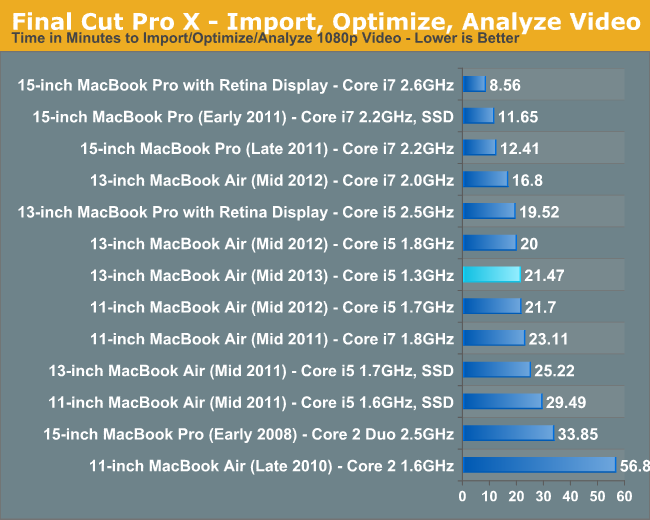
Once again, we see roughly the same performance from the 13-inch 2013 1.3GHz i5 as the 11-inch 2012 MBA. Here we do see substantially better performance than the 2011 models.
Our two photo workloads generally agree with what we saw in the video tests. The 1.3GHz Haswell part is definitely slower than th e previous generation 1.7/1.8GHz SKUs:
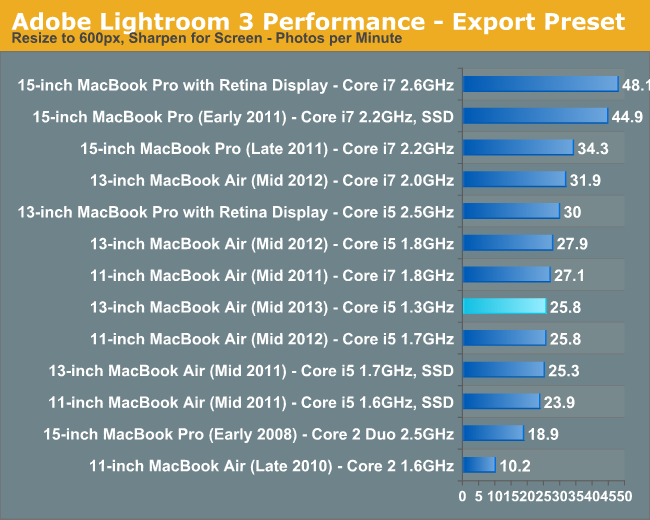
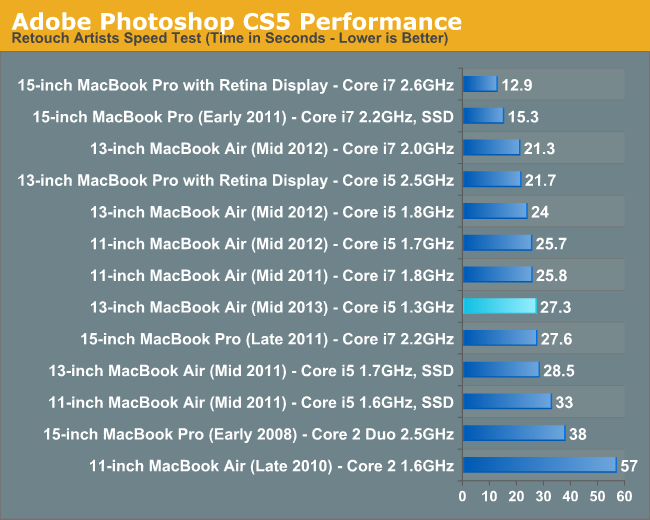
In our desktop review of Haswell I noted that performance in our compile test improved tremendously with the new architecture. As it's quite obvious that Haswell's IPC advantages don't surface all that much in our traditional suite, I wanted to see if perhaps things would be different in something that might lend itself better to Haswell's IPC improvements. I repeated our Firefox build test but under OS X. It's a multithreaded compile, with the number of threads set to 2x the number of cores (not threads) in a system. Unfortunately I came up with this bright idea while traveling, so I only had access to three machines: the 2013 13-inch MBA, the 15-inch rMBP and a 2GHz Core i7 2012 13-inch MBA. I'll add more results later, but I'm expecting this to be a part of our test suite going forward.

The combination of Haswell and a really fast SSD appears to help narrow the gap between the much higher clocked 2012 model and the base 2013 13-inch MBA. Here the faster Ivy Bridge CPU is less than 2% quicker. I'll reserve final judgements until I get my hands on the 1.7GHz Core i7 model, but my guess is this is an example of the best case scenario for Haswell where you get equivalent performance to a higher clocked Ivy Bridge part but with much better thermal/noise/battery life characteristics. For example, the fan was never audible on the 2013 MBA while running this test compared to running at a very noticeable volume on the 2012 Core i7 model. The same goes for temperatures. The i7 2012 model tends to run about 5% warmer along the bottom of the chassis compared to the 2013 i5.










233 Comments
View All Comments
JDG1980 - Monday, June 24, 2013 - link
I think we should have seen noise and thermal measurements, especially since this is Haswell. Will you be able to sit it on your lap without burning yourself? The desktop Haswell chips get nearly hot enough to boil water. I don't believe Intel's official TDP ratings for Haswell; the 4770K allegedly dissipated only 84 watts, but generated more heat than a 130W Sandy Bridge-E.Assuming you plan to use OSX (I can't stand it myself), the low resolution is a real killer. Windows is the only OS that has good font rendering at low DPI (via ClearType). On OSX everything is a blurry mess, and on Linux it's even worse. (Rendering at low DPI is much harder since they have to use a bunch of hacks like hinting and sub-pixel antialiasing to get the font to fit the pixel grid and look reasonably clear.)
It's disappointing to see Apple using Elpida RAM; it's far worse than Hynix or Samsung. And end users shouldn't expect to get the Samsung panel reviewed here; they will almost certainly end up with an inferior LG panel unless they return the system and complain. That's what happened with the rMBP last generation. The sales tactics came close to bait and switch, IMO: send out a good product to reviewers, then after a few months of sales, switch to inferior parts for future production without any indication on the packaging or labeling.
FwFred - Monday, June 24, 2013 - link
Temperature != heat. Also, there is no IHS on a mobile part, so the CPU die may directly be mounted against the cooling solution.mavere - Monday, June 24, 2013 - link
No IHS means no TIM issues means TDP has an extremely, extremely strong correlation to heat and noise, especially as teardowns show similar internal construction. Like the review said, TDP is respectably lowered in Haswell.>>> "It's disappointing to see Apple using Elpida RAM; it's far worse than Hynix or Samsung."
By what metric? Are you claiming that the RAM won't reach their rated speeds? Or are you claiming there's a pending RAM death situation here?
I would love citations in any case.
star-affinity - Monday, June 24, 2013 - link
Don't agree on OS X. It's great overall, once you get used to it. A good start is to not expect everything to behave like in Windows. Also don't agree on the font rendering. If you think it looks better in Windows I'm guessing you're not really into graphic design?tipoo - Thursday, November 6, 2014 - link
I think it does look better, I'm not a graphic designer. However I know OSX may have fonts that are more true to what they were designed as, Cleartype dramatically improves edges on low res displays and makes them bearable. Each pixel effectively becomes three pixels of resolution, so edges are much much smoother. OSX may have "truer" fonts, but chunky looking.A5 - Monday, June 24, 2013 - link
That 130W SB-E die is significantly larger than the 84W Haswell die. Once you add in the fact that more of that TDP is actually being used due to the on-package VRMs, it is pretty obvious why a Haswell would be hotter at the same loads.Paapaa125 - Monday, June 24, 2013 - link
I just used MBA 2011 11" model and the resolution is just fine. At normal viewing distances (30-40cm) the text look clear - no pixels. 135ppi at 40cm means one pixel covers 1,5 arcminutes. That is actually very small unit and quite close to eye resolving power. Definitely you can see the pixels when viewing closer but for normal distances the resolution is 100% sufficient for getting the job done.helloworldv2 - Monday, June 24, 2013 - link
I've been running some terminal stuff for multiple hours with the new i7 model (8GB RAM) utilizing 100% of both cores (4 cores with hyperthreading) and at no point the laptop got uncomfortable to hold on lap (bare skin)..akdj - Wednesday, June 26, 2013 - link
A) Thermal measurements. BS. You don't think the reviewer would've brought to our attention the fact he burned his lap while watching a movie? It's drawing less power at lower clock speeds...there isn't an expectation that the 'heat' on the outside would be anymore significant than the 11/12 core i models. Noise was commented on. In comparison to last year's model, it was quieter while rendering I believe. As well...he mentioned several times throughout the article his anticipation testing the i7 model when he's done flying around the world....yet still submitting a tremendous 'initial' over view or the new Airs. Believe Intel or not....these are 15watt chips. Not 85. Not 130. They're not gonna hurt ya bud.B) OSx. Now your comments are becoming a bit more clear. I use Windows 7/8 and OSx daily. Your comments on text are clearly based on 'what you've heard' and nothing to do with reality. In fact, my friend...'Tis Windows that has awful 'scaling' implementation when it comes to hiDPI displays....including any non native Windows software on the Surface pro. Very troublesome and hopefully will be addressed in 8.1. You're comments on a 'blurry mess' are nothing but BS. @ over 135 dpi on the standard 11" Airs, the resolution in relation to the size of the monitor are just fine! 1080p on that sized display without the same pixel doubling tricks used on the rMBPs would be truly unreadable for most folks over 12 years old! Seriously! I'm an Air and rMBP owner....as well as a PC high resolution display owner. While windows does have some benefits to 'ClearType'....OSx has NO issues with text display. While I'd like to so them step up to IPS, their TN panels, out of the box...have lead the industry for years. Objectively and subjectively. There is NO argument. Windows...on the other hand....they've got a way to go. ClearType isn't the answer. They'll need to implement the same trickery as OSx for text display on HiDPI monitors. No one can see, much less make use of a 2880x1800 display in native Rez. That's the cool thing OSx has managed to pull off....while pixel doubling for text...pics, video, and other creative work can be displayed @ it's native resolution while 'inside' an app using the pixel doubling for its interface. EG; photoshop, FCP....where you CAN have the entire 1080p, every pixel represented inside your canvas while the UI remains usable and crystal clear
Elpida RAM. You are awar that Apple has achieved near 100% efficiency now with their 'soldiered in' RAM. Something NO other user replaceable RAM system can compete with. There are no issues with Elpida...other than the fact you've not heard about them.
LG vs Samsung...very, very arguable. I ended up with an LG in one of our two rMBPs. In four months, image retention set in and Apple immediately replaced it. No questions asked. That said, LG is one of the Biggest and Best panel manufacturers in the world. LG panels in comparison to Samsung have shown better contrast, white and black point....and higher brightness. My Samsung is warmer, but calibrated I've got it pretty close to 6500°. LG is absolutely NOT 'inferior'. They changed out their original panel in the rMBP with an updated version. This is new technology, after all....there are going to be hiccups.
Your 'bait n switch' conspiracy theory is just that. As a small business owner....and as fa from a 'tech reviewer' as one could be....each of my rigs has performed in parity with reviewed models from sites like Anand. No different.
You're full of a WHOLE LOTTA hot air....and obviously have some sort of vendetta against Apple and OSx. Not sure why, maybe your mom said 'Absolutely Not!' When you asked if she would buy you one. Who knows...but quit with the drivel
gxtoast - Monday, June 24, 2013 - link
Fantastic article! However, I just wanted to hit something on the head that seems to be a common misperception:"...In living situations where you can’t just run a bunch of Cat6 everywhere, but still want high speed networking, 802.11ac could be a real alternative."
It seems that most people think that installing Cat6 will give them better 1Gbps Ethernet performance. It won't. Cat6 is irrelevant for 1Gbps. Cat6 is a 10Gbps standard. Cat5e is the 1Gbps standard.
Cheers :)